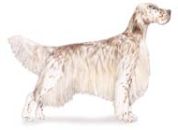English Setter Dogs
Intelligent Hunting Breed
English Setter dogs have been evolving for over four hundred
years and are best known in the field as pointers and bird
retrievers. Their ancestors are believed to include the Water Spaniel,
the Springer Spaniel and the Spanish Pointer.
 Courtesy Commons Wikimedia
Courtesy Commons WikimediaThis breed has the distinction of being participants at one of the earliest formal dog shows in 1859.
The gentleman most credited with the modern-day breed type is Edward Laverack, who began breeding setters in England around 1825. Many of today's top show dogs came from the Laverack lines.
The English Setter dogs are in a class by themselves when it comes to grace, elegance and style. Their lean and well-balanced body is covered with a coat of unusually interesting and attractive coloration.
Characteristics of the English Setter Dogs
English Setters have one of the most friendly and sweetest dispositions and make excellent companions.
They are very
affectionate and people-oriented and love attention. They are always ready to go no matter what their owners want to do - they
just want to make sure they are included in every family activity.
This breed does not enjoy being alone and will experience some separation anxiety if left too long.
They are intelligent and sensitive dogs that respond well to consistent, yet never harsh, training methods. Your Setter will amply reward the time and patience that is committed to training.
Many owners have said they would never have any other breed.

Physical Stats And Care
Height: 24-25 inches
Weight: 40-70 lbs
Color variations: Black/White (Blue Belton), Orange/White (Orange Belton),
Lemon/White (Lemon Belton), Liver/White (Liver Belton), Blue Belton/Tan, and White
Coat:
The long silky coat needs daily brushing to remain in healthy and attractive condition. The texture of the coat tends to
attract burrs or plant debris, so check frequently to prevent matting, especially after field walking.
Most owners
in the know say that bathing every two weeks is needed as well as learning proper dog grooming techniques so as not to damage
the beautiful coat.
Health Notes
The English Setter has a life expectancy of 12 years and is considered an overall healthy breed without significant issues.
The National Breed club recommends the following screenings for the setter:
- BAER Testing (hearing)
- Hips
- Elbows
- Thyroid
The Irish Setter can be subject to Bloat which is a life-threatening condition. Learn more about bloat here.
How Active is this Breed?
This is a very active dog and will not be happy unless he is given plenty of rigorous exercise at least twice daily.
If someone in the family is a jogger, he will be an excellent buddy on a run - once conditioned to the activity..
Ideal Living Space
English Setter dogs will do best in a house with a good-sized yard where they can run and play.
A securely fenced yard is recommended as
these dogs are very good "high" jumpers.
English Setters With Children?
English Setter dogs are a very affectionate breed and have an excellent reputation with children who have already been taught how to be considerate of pets.
However, the caution remains that it is always best to supervise
children when they are interacting with pets.
Senior Or Less Active Families
Were it not for the high exercise requirements, senior or more sedentary owners would adore having English Setter dogs as companions.
Share Your Knowledge and Pictures
Do you have an English Setter? If you do, we know you must be proud to
own this renowned hunting dog. Plus you have the "insider" information
that
would be of great value to others who are interested in this breed!
We invite you to share your Setter's pictures and his/her story as well as your knowledge about the breed in general.
You can upload photos and tell your dog's story here.
For inspiration, read some of the stories already submitted by other dog lovers.
Further Reading

English Setter Comprehensive Owner's Guide
Includes information on breed history, characteristics and standard, puppy selection, feeding, training, health care and behavior of the breed. Also has advice about puppy-proofing the home, preparing for the puppy's arrival, house training and potential puppy problems.
Over 135 color photos.
Image: commons.wikimedia.org/ licenses CC BY-SA 4.0


